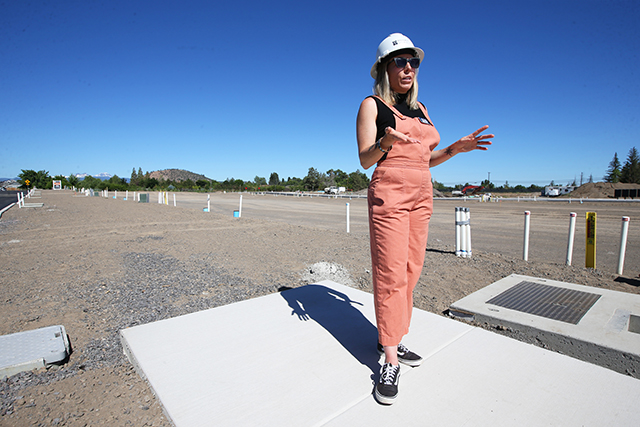Chancellor picks OSU for Bend
Published 4:00 am Wednesday, February 7, 2001
Oregon State University leaped ahead of rival University of Oregon today in their race for a branch campus in Bend when higher education Chancellor Joe Cox announced he is recommending OSU for the job.
”This was an extremely difficult recommendation to make,” Cox said in a news release. While both OSU and UO published strong proposals, the OSU plan earned high marks for its academic design, outreach components, focus on student affairs and historic community relationships, he said.
Trending
Cox’s announcement ends months of speculation and rivalry between UO and OSU, the state’s second and third largest universities and the only two vying for the branch. Until today, the contest appeared to be in a dead heat.
The much anticipated recommendation Cox has remained tight-lipped about which school he was favoring is critical in the match-up between UO and OSU.
It’s expected to carry considerable weight with the State Board of Higher Education. The 11-member board will formally decide between UO and OSU at a Feb. 16 meeting in Corvallis.
”There would have to be a very compelling reason to not accept (Cox’s) recommendation,” said Phyllis Wustenberg, a state board member.
”I think it would take something major like if they completely missed something and that hasn’t happened before.”
Because neither university emerged the clear front-runner before today, Cox’s decision came as a surprise a pleasant one for backers of OSU, an unwelcome one for UO fans.
Trending
”I am disappointed, surprised, I disagree with it, and … I will await the board’s decision,” UO Provost John Moseley said earlier today.
Moseley, who has spearheaded OU’s branch campaign, said he doesn’t plan to challenge Cox’s decision or appeal directly to the state higher ed board, although his staff will review Cox’s analyses of the two proposals.
”We will analyze them, but we’re not going to take any unilateral steps,” he said. ”The board usually takes Mr. Cox’s recommendation, but sometimes they don’t. And I think in this case they have a responsibility to take a hard look at this.”
OSU President Paul Risser said today his staff will begin working immediately to organize a transition team to start laying the groundwork for a branch. He said his staff has scheduled a meeting with COCC staff the day after the state board meeting to begin working on the transition.
”Of course, it feels good, but I want to give credit to the University of Oregon. I don’t think this was a case of one proposal being better than the other, they were just different,” Risser said.
He said the first order of business will be to form a local advisory board that will immediately begin a search for a director of the branch. OSU had planned to call the top branch administrator president, but Cox, among other suggestions, recommended using another title.
”And that’s fine. I don’t have any quarrels with any of the chancellor’s recommendations,” Risser said.
Cox also suggested OSU work closely with the chancellor’s office to complete an implementation plan by April 1.
Working at a feverish pace, Cox and his staff worked through last weekend to complete a financial and educational analysis of both schools’ proposals. He used those analyses plus a recent side-by-side comparison of both proposals and evaluations by independent consultants to help him make his recommendation.
While several members of the Central Oregon Regional Advisory Board came out publicly for OSU, the board’s official position lauded both proposals and maintained that either would serve Central Oregon well. COCC faculty, who will partner with the branch to offer lower-division courses, largely favored UO in their analysis.
In their bids for the branch, both schools also had to overcome several obstacles. UO was regarded as having come late to the race for the branch, and OSU was criticized for waging an aggressive and at times inaccurate public relations campaign.
But Cox said he judged both schools solely by their proposals and how well each plan would fit into the university system as a whole.
OSU offered the more sweeping plan, offering an array of degree and certificate programs designed specifically around Central Oregon’s needs. The school emphasized engineering and computer technology programs and would leave most of the traditional liberal arts and sciences courses to students’ freshman and sophomore years at COCC.
OSU also focused heavily on technical training programs and offered a range of cultural programs.
In contrast, UO proposed a more traditional liberal arts and sciences curriculum, arguing the branch should start with a simple, but solid framework and add specialty programs as enrollment climbed.
While OSU’s proposal seemed to more closely match the region’s unique character, UO’s plan was generally considered superior in student recruitment and featured a greater number of faculty after five years, largely because UO planned to use more COCC faculty in joint professorships.
Though OSU has taken the lead now, whether a Beaver branch will actually materialize is still uncertain. With Cox’s recommendation and the state board’s decision to follow, it will then be up to Central Oregon’s muscle in the state Legislature to make sure the $7.2 million in start-up funds is not cut from the proposed state budget.
With a less than stellar proposed budget for higher education, the fight for dollars especially for the $7.2 million for a new branch is sure to be contentious.








